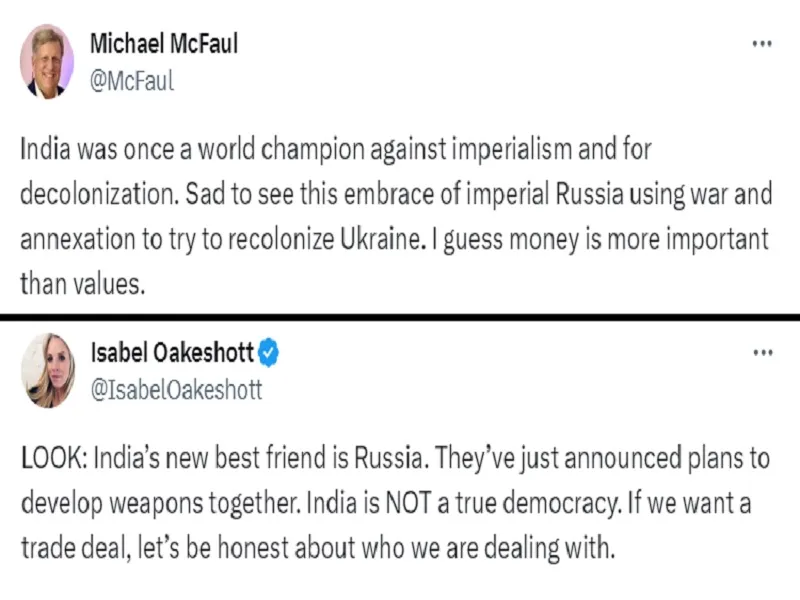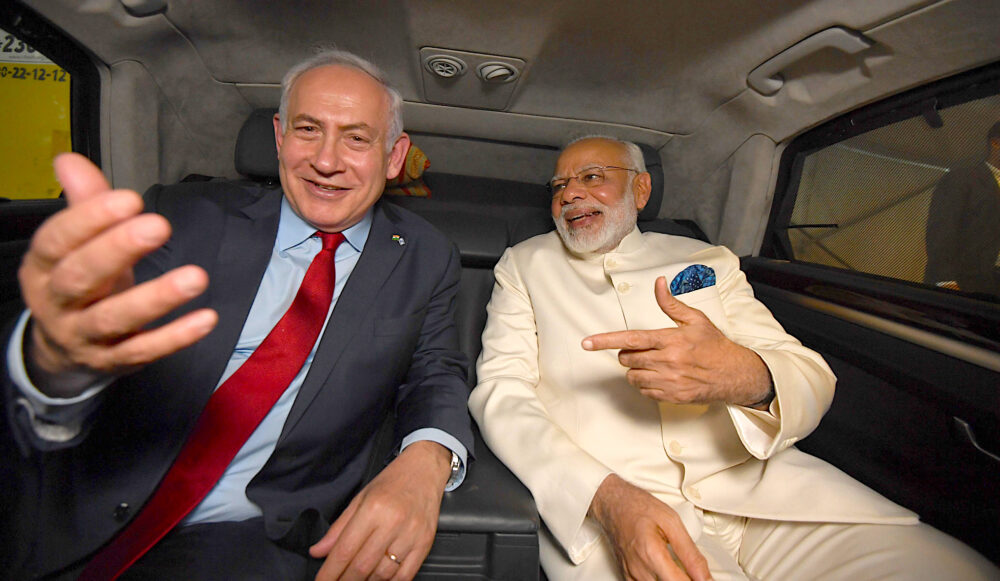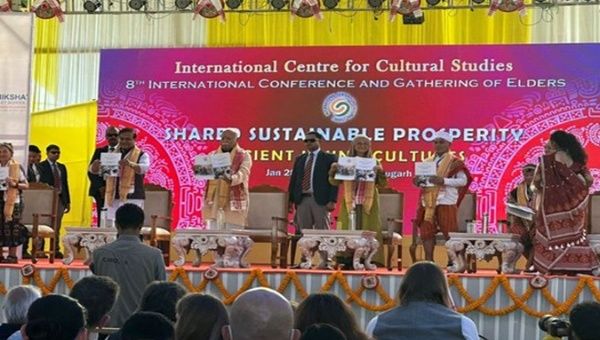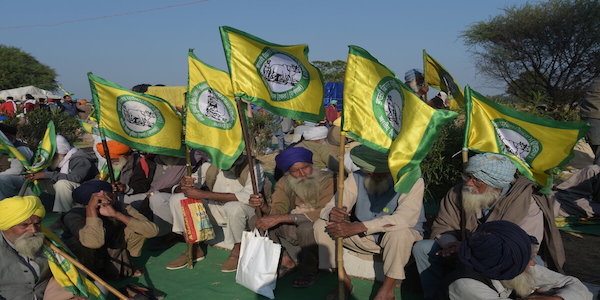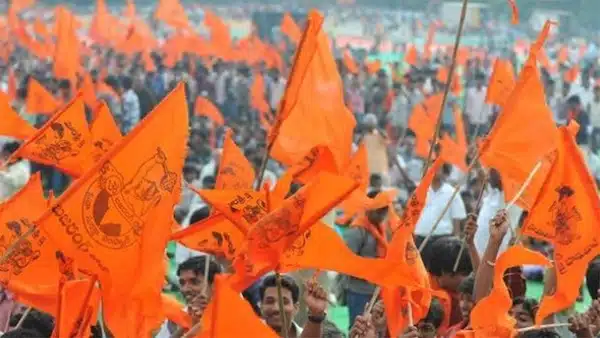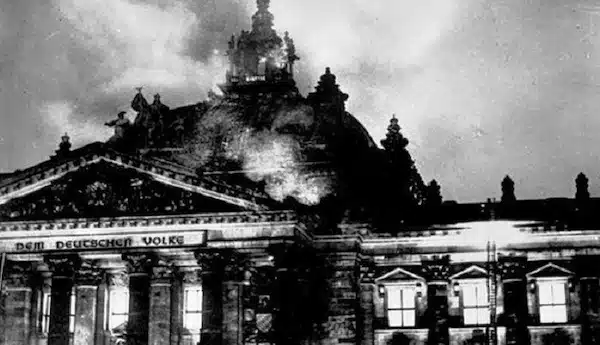How the People’s Science Movement Is Bringing Joy and Equality to Education in Karnataka, India
FEBRUARY 13, 2024
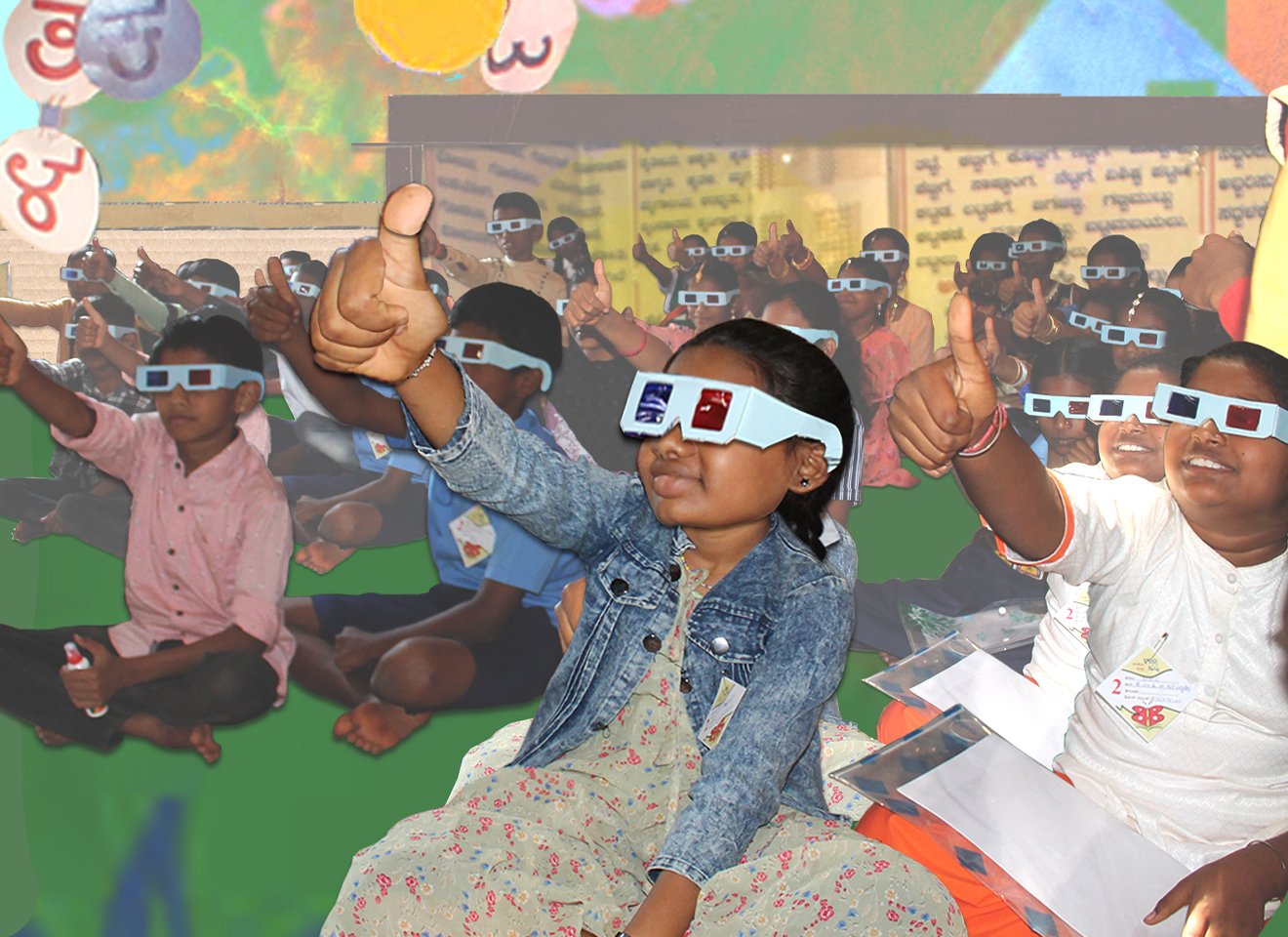
The collages in this dossier were created by Tricontinental: Institute for Social Research based on reference photographs by Satarupa Chakraborty during the 2023 Joy of Learning Festival in Siddapura. These photographs are intertwined with images cut out from the Joy of Learning Festival Handbook (Kalika Habba Kaipidi), published by the Samagra Shikshana Karnataka (Department of Primary and Secondary Education, Government of Karnataka) in 2022.
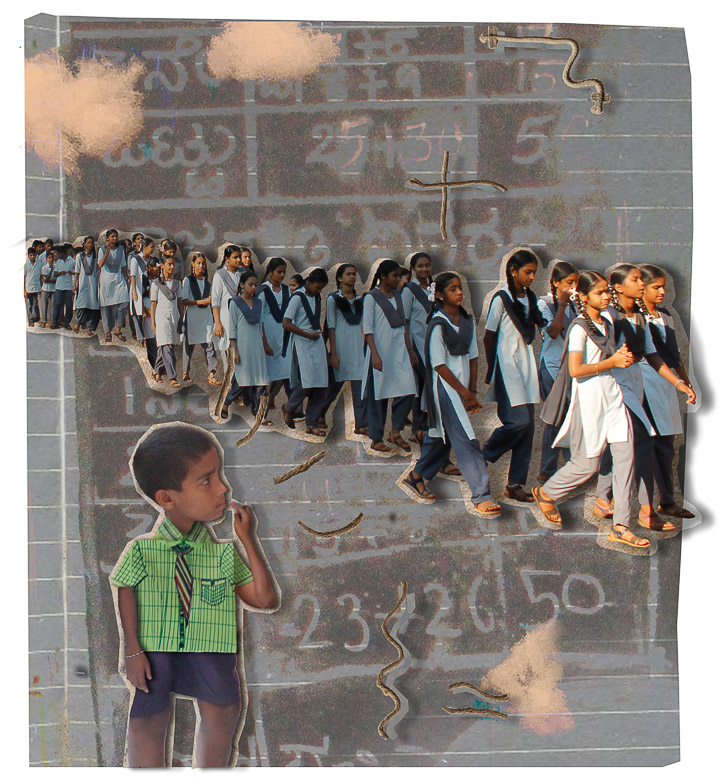
Students from various schools in Siddapura and nearby villages participate in a rally to inaugurate the 2023 Joy of Learning Festival in Siddapura.
The People’s Science Movement in India has few parallels in the world in concept, scale, and scope. The movement started out popularising science in a young independent nation in which the majority (87.8%) of the population was illiterate, let alone conversant in modern scientific concepts.1Navinchandra R. Shah, ‘Literacy Rate in India’, International Journal of Research in All Subjects in Multi Languages 1, no. 7 (October 2013): 12–16,
https://www.raijmr.com/ijrsml/wp-conten ... _07_04.pdf.
FOOTNOTE
It went on to craft a complex role for itself, embracing a rigorous understanding of science that encompasses both natural and social phenomena as well as the interactions between them. Since its founding in the 1960s, the People’s Science Movement has worked to democratise the generation of knowledge and its dissemination and integration in Indian society, centring the sociocultural consciousness of the Indian people. The movement sees scientific thinking and the application of scientific principles as necessary in building a society that questions and understands inequalities and eventually chooses the path to break oppressive hierarchies. A consciousness that is imprisoned in religious dogma, that passively accepts tradition and superstition, and that is unable to enquire into and analyse nature and society does not have the scientific tools necessary to build an equal social world.
This dossier, How the People’s Science Movement Is Bringing Joy and Equality to Education in Karnataka, India, focuses on the pedagogy and philosophy of the movement’s work with school children in Karnataka, a state in southern India with a population of 69 million people. It is built upon interviews with teachers and activists of the People’s Science Movement as well as Tricontinental: Institute for Social Research’s participation in the Joy of Learning Festivals (also known as Kalika Habba) that took place in Karnataka from December 2022 to February 2023.
The Origins of the People’s Science Movement
In its early years, the primary focus of the People’s Science Movement was to popularise science, explaining complex issues in accessible, everyday language and countering superstitious beliefs that pointed to witchcraft as the cause for disease, death, and disaster.2T. M. Thomas Isaac and B. Ekbal, Science for Social Revolution. The Experience of Kerala Sastra Sahitya Parishat (Trichur: KSSP, 1988); M. P. Parameswaran, ed., Science for Social Revolution (Thrissur: KSSP, 2013).
In this period, the movement was largely made up of a number of scattered organisations, many of them concentrated in the southern state of Kerala. The most significant of them, the Kerala Sasthra Sahitya Parishad (Science Writers Forum of Kerala or KSSP), was formally inaugurated in 1967. Several of the key people involved in this movement studied in the Soviet Union and brought the advances made by the Soviets back to India. M. P. Parameswaran, for instance, studied nuclear engineering at the Moscow Power Institute (1965) and returned to Bombay to set up the Federation of Indian Languages Science Association in 1966, eager to popularise the sciences in his country.
The People’s Science Movement has its roots in India’s national movement for independence, which had a clearly anti-imperialist view of the sciences. In contrast to the colonialist use of science as an instrument for exploitation and profit, the scientists of that era saw their field as a core element of the path for emancipation from drudgery and oppression and sought to combine, as Amit Sen Gupta wrote, the ‘liberating potential of science with the awareness that science can thrive only among people who are truly free’.3Amit Sengupta, ‘Learning from the Past and Looking to the Future’, in Science for Social Revolution, 68. Also see, Prabir Purkayastha, Indranil, and Richa Chintan, ed., Political Journeys in Health. Essays by and for Amit Sengupta (New Delhi: LeftWord Books, 2021) and Prabir Purkayastha, Knowledge as Commons. Towards Inclusive Science and Technology (New Delhi: LeftWord Books, 2023).
The importance that the newly independent nation gave to the sciences is reflected in the Indian Constitution (Article 51A), which states that ‘It shall be the duty of every citizen of India… to develop the scientific temper, humanism, and the spirit of inquiry and reform’.4The Constitution of India, Ministry of Law and Justice, Government of India, 26 January 1950,
https://www.refworld.org/docid/3ae6b5e20.html, 25.
When independent India chose to embark on an autonomous path of development and break from the imperialist centre of gravity, it became imperative to generate scientists, engineers, doctors, and other such modern scientific professionals who could build a strong base for the development of science and technology. This endeavour had to confront the country’s largely backward rural society, which was beset by a multitude of regressive practices. The People’s Science Movement was able to make significant progress in this regard by nourishing intellectuals, from teachers and engineers to doctors, researchers, and scientists who were products of the vibrant culture of post-independence academia rooted in a strong interest in national development, many of them part of the students’ movement or influenced by the socio-political discourses of that milieu.
In the years following India’s independence, the state developed quality educational institutes to form a pool of forward-looking, critically thinking intellectuals who would not only lay the groundwork for the country’s autonomy in scientific research and technological and industrial development but would also be catalysts in breaking the deeply rooted fetters of feudalism. Nonetheless, the truth is that they were largely inaccessible to most of the population, limited in part by the insufficient public resources allotted to them. Even improvements in literacy were – and continue to be – slow, with millions of children growing up without stepping into schools or having stepped out of them too soon.5National Sample Survey of Estimation of Out-of-School Children in the Age of 6–13 in India, Social and Rural Research Institute, September 2014,
https://www.education.gov.in/sites/uplo ... Report.pdf.
FOOTNOTE
In this context, the KSSP, supported by the left movement in Kerala, developed innovative science literacy programmes. One such programme was the formation of cultural troupes known as kalajathas in the 1970s through which activists brought science closer to people, particularly in villages, through art, music, dance, and theatre. This inspired similar campaigns in states across the country as well as the formation of the Bharat Gyan Vigyan Samiti (Indian Association of Knowledge and Science or BGVS) in various states, including Karnataka. Drawing from the KSSP’s work in Kerala, the BGVS became the primary force driving the People’s Science Movement in Karnataka and a key actor promoting science in many states across the country.
In 1984, a gas leak and explosion at the Union Carbide factory in Bhopal, in the state of Madhya Pradesh, spurred the formation of many science literacy groups across India, several of which set out to explain the criminal aspect of the leak and explosion and bring justice to the survivors and victims. Many of these groups began to work together, culminating in the formation of the Bharat Jan Vigyan Jatha (Indian People’s Science Association or BJVJ), which sought to increase popular literacy about science across the country. This process led to the formation of a national network of twenty-six science organisations in 1988 called the All India People’s Science Network (AIPSN).
As the AIPSN made its mark in the country, several government agencies approached it to assist with the National Literacy Mission, whose aim was to increase adult literacy in rural India. The AIPSN saw an immense opportunity in the mission to make its science literacy efforts nationwide. Soon, BGVS units in each state formed a network through the AIPSN to assist in the mission while maintaining their independence.
Through these all-India government programmes, the AIPSN was able to grow in northern Indian states, where progressive movements have been historically unable to develop a strong presence. During this adult literacy movement, the AIPSN was able to reach 60,000 villages in various states across India through the BGVS – an unprecedented exercise in which thousands of activists, teachers, and students travelled across the country to teach the people of rural India. Though the People’s Science Movement has a long history of building activities to promote science among children, the incorporation of tens of thousands of schoolteachers into the literacy movement through the BGVS allowed these practices reach classrooms on a much larger scale and propelled the democratisation of the science movement.
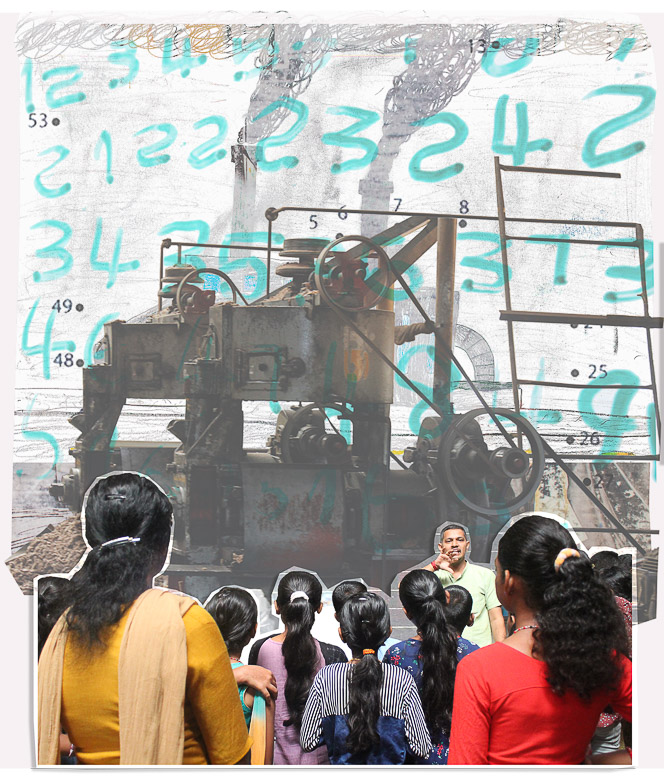
The owner of a coconut oil factory explains the production process to students during the 2023 Joy of Learning Festival in Siddapura.
Neoliberalism and the Science Movement
The BGVS and AIPSN took off in the late 1980s to early 1990s, a period when India’s ruling class was imposing a neoliberal framework on the country. As AIPSN activists fanned across the country to promote literacy and combat superstition as a basis for scientific knowledge, forces of the far right travelled across India to build a campaign to demolish a sixteenth century mosque in Ayodhya, in the state of Uttar Pradesh, plunging the country into social division. Since then, the AIPSN has worked to intervene in a society that has become increasingly ravaged by the rising legitimacy of religious fanaticism and conservatism as well as the wrecking of knowledge and education systems by neoliberal forces.
These neoliberal forces have changed the long-term direction of India’s education system.6For more on this neoliberal shift, see: Nitheesh Narayanan and Dipsita Dhar, eds., Education or Exclusion? The Plight of Indian Students (New Delhi: LeftWord Books, 2022) and Satarupa Chakraborty and Pindiga Ambedkar, eds., Students Won’t Be Quiet (New Delhi: LeftWord Books, 2022).
While the deeply rooted maladies of scarce funding for and access to education persist, this national vision for education has narrowed to do little more than supply a cheap workforce equipped with skills that benefit national and international capital at the expense of a well-rounded education that fosters critical thinking in society. Learning anything beyond the immediate technical skills that are required to feed into industries is not only seen as a serious waste of public resources, but also a threat to existing authoritarian social structures and state actions. In this exam and profit-oriented system, those without resources who cannot complete their education, and those who do get their degrees, are united by the fact that they are being ejected into a cheap, abundant, and docile labour pool. The reduction of government funding under neoliberalism has deprived millions of children of primary education while the families of millions more go into permanent debt to pay for private school. These private schools maximise profit by raising fees and paying teachers minimal salaries while failing to provide conditions that are conducive to education.7Public funds are now also being transferred to private schools. The chief minister of the Haryana Equal Education Relief, Assistance, and Grant scheme (CHEERAG), for instance, is encouraging parents to send their children to private schools, for which the government would bear a minimum cost. Simultaneously, the government has introduced fees in its own schools. For more, see Satyapal Siwach, ‘Haryana Teachers Protest Against CHEERAG’, Peoples Democracy, 7 August 2022,
https://peoplesdemocracy.in/2022/0807_p ... st-cheerag.
The neoliberal approach to education depletes the constitutional mandate to science and encourages a blind adherence to irrational and often hateful and violent thoughts and actions, including a distorted but prideful view of ancient history and a disregard for the accurate history and systems of science. For instance, textbooks in the state of Gujarat claim that ancient India possessed genetic engineering skills because the children of Kunti (the mother of the Pandavas in the fourth-century epic Mahabharata) were born outside of her womb. Meanwhile, the high court in the city of Allahabad in the state of Uttar Pradesh ruled in 2021 that cows exhale oxygen, and India’s Prime Minister Narendra Modi claimed in 2014 that ancient India excelled in plastic surgery as evidenced by the Hindu Lord Shiva, who replaced the head of his son Ganesh with an elephant’s head. This logic enables capital to get its docile labour while society gets a population that looks for solutions for its misery in all the wrong places.
It is important to note that, unlike NGOs that operate in the social sphere, the People’s Science Movement keeps its distance from neoliberal funding. For example, the BGVS in Karnataka strictly eschews any corporate and institutional funding, such as from the World Bank and even from United Nations agencies. While it works with the government, it does not take government funds and fully depends on people’s contributions.
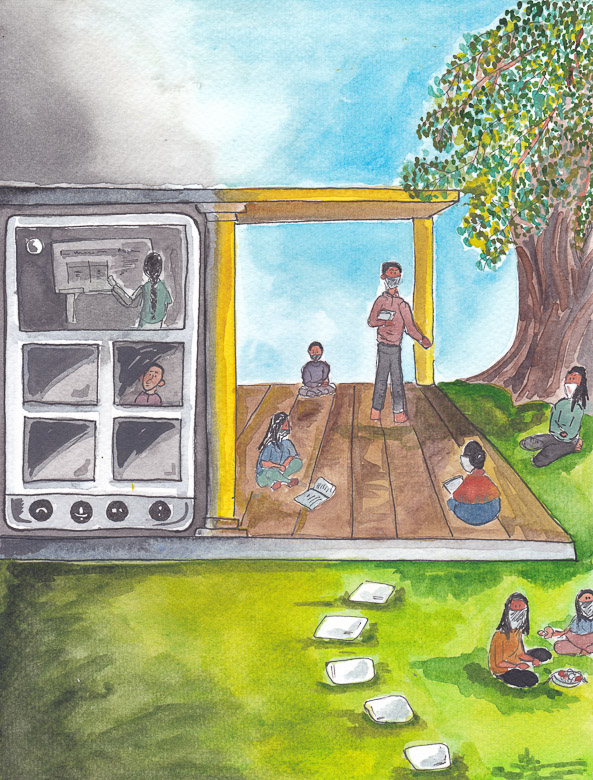
The cover of this issue of the BGVS’s monthly magazine, Teacher, in 2021 depicts the neighbourhood schools that the organisation initiated at the onset of the COVID-19 pandemic.
Credit: Megha Ramachandra
The BGVS’s Neighbourhood Schools
It was in this context of the onslaught of neoliberalism, the increasing suffocation of public education, and the widening socioeconomic divide between private and public schools, beginning in the 1990s, that the BGVS expanded. Through the strength of activist teachers, the BGVS has made use of every opportunity to challenge, change, and transform the prevalent pedagogical methods in schools in various Indian states. The BGVS has been actively involved in developing and implementing a creative methodology of teaching to counter the elite bias in education that alienates children from learning, the unscientific teaching methods that kill the inquisitiveness of children, and the harmful influence of caste and religious dogma on young minds.
When the COVID-19 pandemic hit and neoliberal institutions insisted upon online schooling in a context in which most children had no access to the internet or to computers (while those who had access to online education did not learn anything meaningful), the BGVS in Karnataka initiated neighbourhood schools (vatara shalas). Government schoolteachers volunteered to run these schools in community halls and public spaces, such as the courtyards of temples, mosques, or churches, in accordance with pandemic-related health advisories. The initial sixty-odd neighbourhood schools, mostly in rural areas, were possibly the first organised response, at least in India, to address the education disruption after the initial lockdowns were lifted in April 2020, drawing support from parents as well as attention from the media. This compelled the government to announce its support for the neighbourhood schools. By the end of the year, there were more than 35,000 neighbourhood schools across Karnataka.
Through the successful experience of the neighbourhood schools, the BGVS was able to convince the government education department to mitigate, to some extent, the government’s fixation on market-driven ‘learning outcomes’. The pedagogy of the neighbourhood schools inspired large numbers of volunteer teachers to get involved who then helped convince the education department of their importance. This resulted not only in additional government support for the neighbourhood schools but also for the Joy of Learning Festivals as the worst of the pandemic came to an end by 2022.
The Joy of Learning Festivals
Joy is essential for learning. This outlook is encapsulated by the singing and dancing of students and teachers alike as part of the festivals’ methodology to teach science. There are two core components of the festivals’ methodology: first, the four learning corners into which the festivals’ activities are divided, and second, a ‘guest-host’ programme through which children from other villages are paired with students in the local village across barriers such as caste, language, and class, living and working together in pairs for the duration of the festivals. While the guest-host programme is not yet implemented in every festival (and is in fact only present in a minority of them at this stage), it is key to the festivals’ methodology and their goal of breaking down socioeconomic divisions within Indian society, with the intention to increase in scale in future years.
The 2022–2023 Joy of Learning Festivals extended the methodology developed by the neighbourhood schools and built upon the experience of the 620 festivals that the BGVS conducted in 2019, before the pandemic. In contrast to the neoliberal solutions for the knowledge gap that was exacerbated by the pandemic, these children’s festivals are discussed, designed, and implemented by the teachers themselves, with the participation of parents, elected members of village panchayats (local self-governments), school development monitoring committees, and others. More than 35,000 teachers and 1 million children participated in the 2022–2023 Joy of Learning Festivals, which were organised in more than 4,100 clusters (each cluster is a group of schools, grades 8–12, located within a given geographical area).
The children touch, feel, experiment, and explore the subject matter on their own, providing the teacher with an opportunity to explain the mechanics and scientific theories underlying the activity. This approach encourages children to experiment, observe, understand, analyse, and find meaningful patterns in nature and society while working in a collective team. Such activities go beyond a more traditional approach that is limited to lectures and textbooks, drawing in not only the children but also their parents in the small villages where these festivals are held.
Raveendra Kodi, an assistant teacher in the Udupi district in Karnataka, reflected on this form of teaching:
Learning should go beyond the classroom; it should be enjoyable and experimental, and it should develop children’s curiosity and their ability to think creatively and engage critically. We are focused on how to make learning interesting to children.
Uday Gaonkar, a science teacher, cultural activist, and BGVS leader, explained that while children often hold themselves back from asking questions in a typical classroom setting, they usually participate more if they are in a playful environment. This space for open interaction is important for their intellectual growth. The science movement’s pedagogy is, thus, distinct from the conventional classroom method of teaching that often creates a divide between ‘good students’ and ‘bad students’ based on an adherence to uncritical head-nodding over critical thinking and hands-on engagement. Uday Gaonkar reflects on the use of this ‘learning by doing’ approach:
All four corners are divided into two age groups. For example, when children between the ages of 10–13 study a tree, they study it differently than those who are older. The same activities can be performed in different ways by different age groups. The older children use somewhat complex trigonometry formulas, which the younger ones cannot do. But students of all age groups enjoy these activities, as do the teachers. The activities in all corners of learning are designed in such a way that no experts are required; any teacher can facilitate them. These activities help students learn different things without being told what they are learning.
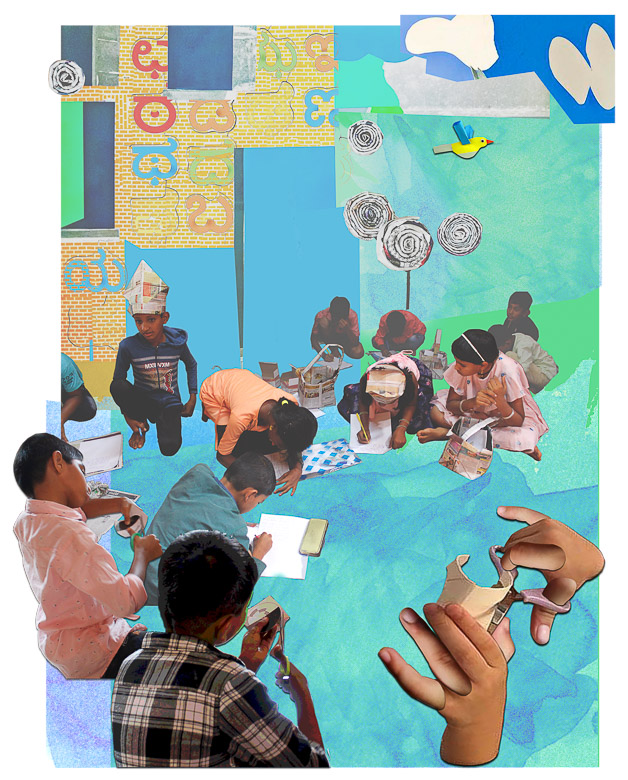
Students participate in activities at the Kagadha Kattari (crafts, or ‘paper and scissors’) corner.
The Four Learning Corners
The festival is organised into four learning corners: ‘let’s find out about the village’ (Uru Tiliyona); science, or ‘let’s do it’ (Madu Adu); language development, or ‘singing and playing’ (Hadu Adu); and crafts, or ‘paper and scissors’ (Kagadha Kattari). All of these learning corners are meant to develop curiosity, observation and interactive skills, group learning, and scientific thinking among children.
1) Uru Tiliyona (‘let’s find out about the village’)
In the Uru Tiliyona corner, students take a short village tour during which they interview the people, learn about their culture and the biodiversity in their communities, study and practice how to conduct measurements, and, finally, prepare a village map. The participants undertake four main activities:
Studying the ecology of a defined space.
Studying a specific object or area, such as a tree, the land, or the surrounding environment.
Making maps of a geographical location.
Interviewing the villagers.
This methodology can be used to study other aspects of village life, such as how electricity is used. In one activity, children visited ten houses and collected basic information on electricity use: how many people live in a given house, how much electricity the household uses, and how much they pay each month for electricity. Based on this information, they calculated the per capita electricity consumption and then shared the results of their study with the villagers.
Another activity taught students about local biodiversity. During one of the festivals, an older woman carrying an armful of leaves paused and helped the teachers explain why a particular type of tree grows in the region and how villagers benefit from it. Students then went to a nearby coconut oil factory, where the owner stopped production for an hour to explain how the oil is made, how coconuts are used to make different products, and how the machines work. ‘These are not only children’s festivals’, BGVS organisers said; ‘These are village festivals’. This brief walk with the children made that abundantly clear, as the entire village interacted with the festival in different ways.
2 )Madu Adu (science, or ‘let’s do it’)
In this corner, children learn how certain experiments lead to definitive results through playful activities rooted in scientific concepts. This learning corner is extremely popular because of its use of stories, song, and dance. Activities include:
The Newton-Benham snow wheel, or the disappearing disc, experiment: When a disc displaying primary colours is spun, the colours appear to be white, which facilitates a discussion about visual perception.
Learning the science of friction by making and playing with toys whose materials demonstrate sliding resistance.
Replicating a conference call using paper cups and strings to learn how sound travels.
3) Hadu Adu(language development, or ‘singing and playing’)
This corner focuses on language development, critical thinking, and collective activities. The activities in this corner bring out myriad expressions through games, songs, performances, and conversations and help children open up to the world through words and other forms of expression. Ashok Thekkatte, a teacher in charge of this corner, explained:
Hadu Adu is a sector for language development, and, through singing, dancing, and some other activities, we encourage children to work in teams. There is one activity where we give the children two rhyming words and ask them to find another two rhyming words, and then they compose poems by themselves. This exercise helps them to gain a command over the language.
4) Kagadha Kattari(crafts, or ‘paper and scissors’)
This corner provides a space for children to experiment and be creative with various materials. The teachers tell stories that the children are inspired to illustrate. This activity is less structured and more open-ended than the other corners, leaving the space for children to lead the activity themselves and use the paper, scissors, and pens that are provided to create different shapes, dolls, and pictures. Through activities such as origami and paper crafts, children learn precision, neatness, and concentration.
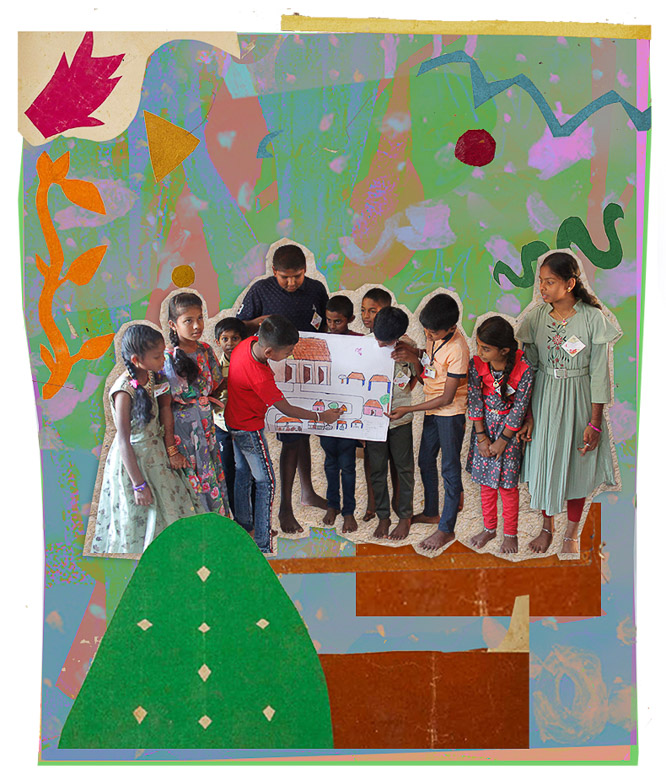
A group of students present the map they made after touring the village as part of the Uru Tiliyona (‘let’s find out about the village’) corner activity.
Breaking Barriers
The Joy of Learning Festivals and neighbourhood schools alike have to confront the regressive aspects of rural society, particularly caste hierarchies. For instance, at one of the neighbourhood schools
– which dominant and Dalit (oppressed caste) children alike attended during the pandemic – dominant caste families objected to Dalit children being allowed into a village temple where the school was located. The teachers decided to move the neighbourhood school to the Dalit part of the village, which upset some of the dominant caste families, who asked the teachers to move the school back to the temple. The teachers said that they would do this only if the dominant caste parents would agree that Dalit children could enter the temple without problems, to which the dominant caste families agreed. As this anecdote shows, teachers are often able to push back against regressive social structures, experimenting with creative ways to break social barriers and prejudices.
Another approach to breaking deeply rooted discrimination that developed in some of the Joy of Learning Festivals is called the guest-host method. For the duration of the festival, children from one district stay in the homes of children from another district who are often from different socioeconomic and caste backgrounds. For instance, during the Siddapura festival, 150 students from the local primary school and their families hosted 150 children from other parts of Karnataka in their homes, working together during the three days of the festival. Each pair of children lived together, ate together, and participated in the activities together, overcoming the social, cultural, economic, linguistic, and other differences between them.
Gaonkar helped us understand this process, which has been built over long periods of struggle:
It is difficult to quantify and say precisely at what scale our festivals are impactful in society. But we certainly have extraordinary experiences. At a festival in Sri Rangapatna, a student from Mangalore named Mohammad Hafil stayed with another student, Punit, for two nights. Hafil was from a well-to-do family, whereas Punit was from a lower income family. There were naturally resource problems in Punit’s home, including the lack of a toilet facility, and even the foods that each student was accustomed to eating were different. Nonetheless, they became fast friends. Before leaving Punit’s house, Hafil wanted to see Punit’s grandmother, who had already left for work in the morning. So, he asked the officials from the education department to take him to the grandmother’s workplace. After meeting the grandmother, the officials asked her if accepting Hafil in her home was difficult as he was from another religion. Punit’s grandmother simply rejected the question.
Though not every instance leads to a more generous understanding, many of them do. At the parents’ meetings, discussions come up where parents express their reticence to host children from other backgrounds. These discussions are important, particularly because the BGVS activists entertain these hesitations to encourage fellowship rather than to silence these public appearances of the obvious hierarchies in society.
Teachers as Organisers
Teachers are undoubtedly the heart of the Joy of Learning Festivals. They decide on the festival’s venue, coordinate the process with the local government, develop the learning corners, and draw the village into the festival. The teachers who experience the Joy of Learning Festivals then teach more teachers, building up the BGVS and further embedding the Joy of Learning Festivals in the villages and Indian society at large.
The BGVS teachers spend roughly fifteen to sixteen hours working on the first day of the festival in high heat and humidity. In the evening, when the students leave, the teachers meet to assess their work and discuss how to improve the festivals. Such discussions reveal the teachers’ work ethic and their constant efforts to create equality within the classroom and reach the most marginalised students. This act of dedication is the result of a vibrant process of training teachers and engaging parents and the village leadership, followed by a tremendous sense of fulfilment that comes with seeing the students enjoy their education.
Conclusion
The Joy of Learning Festivals showcase the philosophy of the People’s Science Movement. Science and knowledge, in this tradition, are not merely academic. Rather than focusing on individual advancement, this creative social endeavour develops students’ ability to think and reflect critically on the world. By involving the entire village community in the festival and by engaging students in the practice of science (including in the study of their agrarian production and their economic realities), the festivals integrate science in the community as part of a broad cultural process that directly responds to villagers’ and students’ surroundings and material conditions, allowing them to develop an understanding based on facts and observations made in their social context.
Manual work in India has long been devalued and kept separate from theory and knowledge, in large part due to the caste system and then exacerbated by the onslaught of neoliberalism beginning in 1991. This creates an environment in which practice, observation, and experimenting play little role in science education. Occupations that are associated with manual labour are derided, their workers deprived of quality education and kept away from theory. Meanwhile, most often, those who learn theory keep their distance from manual labour, creating a divide that is not conducive to scientific development or the development of a scientific temper.
The way that science and technology are practiced under neoliberalism goes hand in hand with the unscientific social attitudes and ideology propagated by India’s right wing. Teaching and practicing science in a way that is hands on, decentralised, experimental, observational, and enquiry-based is vital to cultivating a scientific temper amongst children. The People’s Science Movement’s conception of science not only takes into account natural phenomena, but also analyses the social relations that inform them.
Based on this understanding, the People’s Science Movement has built an easily replicable model for science education through its Joy of Learning Festivals. Though the neoliberal state is compelled – to a certain extent – to adopt these models, they cannot be implemented on a mass scale when the right is in power.
The uniqueness of the People’s Science Movement is that it operates in the spaces made available due to the failures of capitalism, differentiating it from other class-based organisations that, by definition, confront capital with full force. The People’s Science Movement’s approach allows the socialist project to contest the cultural hegemony of neoliberalism and the social toxicity of the right wing, building new spaces for scientific, rational, and humane consciousness.
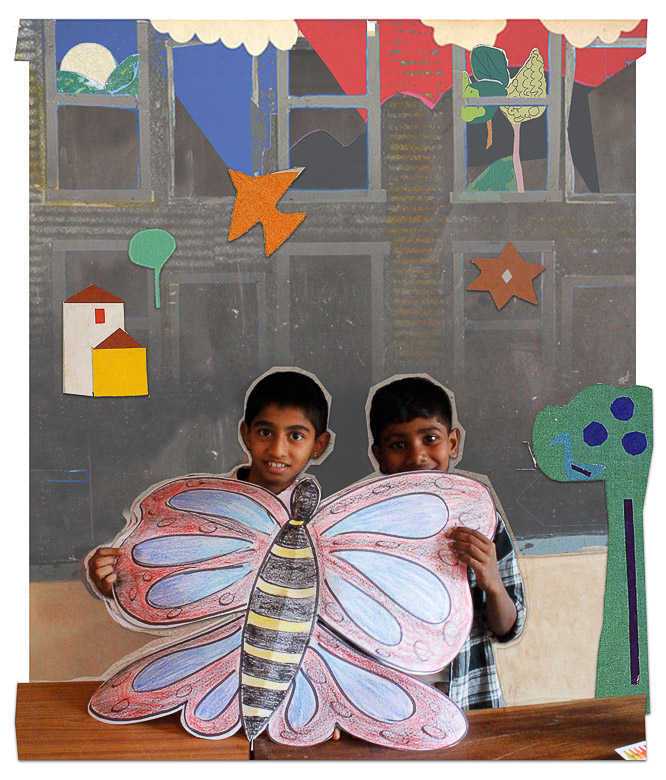
Students display a butterfly they made at the Madu Adu (science, or ‘let’s do it’) corner.
Notes
1Navinchandra R. Shah, ‘Literacy Rate in India’, International Journal of Research in All Subjects in Multi Languages 1, no. 7 (October 2013): 12–16,
https://www.raijmr.com/ijrsml/wp-conten ... _07_04.pdf.
2T. M. Thomas Isaac and B. Ekbal, Science for Social Revolution. The Experience of Kerala Sastra Sahitya Parishat (Trichur: KSSP, 1988); M. P. Parameswaran, ed., Science for Social Revolution (Thrissur: KSSP, 2013).
3Amit Sengupta, ‘Learning from the Past and Looking to the Future’, in Science for Social Revolution, 68. Also see, Prabir Purkayastha, Indranil, and Richa Chintan, ed., Political Journeys in Health. Essays by and for Amit Sengupta (New Delhi: LeftWord Books, 2021) and Prabir Purkayastha, Knowledge as Commons. Towards Inclusive Science and Technology (New Delhi: LeftWord Books, 2023).
4The Constitution of India, Ministry of Law and Justice, Government of India, 26 January 1950,
https://www.refworld.org/docid/3ae6b5e20.html, 25.
5National Sample Survey of Estimation of Out-of-School Children in the Age of 6–13 in India, Social and Rural Research Institute, September 2014,
https://www.education.gov.in/sites/uplo ... Report.pdf.
6For more on this neoliberal shift, see: Nitheesh Narayanan and Dipsita Dhar, eds., Education or Exclusion? The Plight of Indian Students (New Delhi: LeftWord Books, 2022) and Satarupa Chakraborty and Pindiga Ambedkar, eds., Students Won’t Be Quiet (New Delhi: LeftWord Books, 2022).
7Public funds are now also being transferred to private schools. The chief minister of the Haryana Equal Education Relief, Assistance, and Grant scheme (CHEERAG), for instance, is encouraging parents to send their children to private schools, for which the government would bear a minimum cost. Simultaneously, the government has introduced fees in its own schools. For more, see Satyapal Siwach, ‘Haryana Teachers Protest Against CHEERAG’, Peoples Democracy, 7 August 2022,
https://peoplesdemocracy.in/2022/0807_p ... st-cheerag.
https://thetricontinental.org/dossier-7 ... aka-india/
